The last time Inter Miami won a game under Phil Neville was on May 16 in a 3-2 away victory against FC Cincinnati, a team managed by a former teammate of Neville’s at Manchester United, Jaap Stam.
Over two months, six defeats, and one draw later, Miami are currently sitting rock bottom of the Eastern Conference with just nine points from thirteen MLS matches. In fact, the Herons have picked up fewer points than any other club across both the Eastern and Western conferences.
The former Lionesses head coach has been cast into the limelight in the past week as pressure mounts on his shoulders following a humiliating 5-0 thrashing at home to the New England Revolution.
Perhaps there are quite a few problems within the locker room, but what is known for certain is that there are astronomical issues surrounding the team’s tactical set-up under Neville. If these problem areas are not ironed out quickly, the club’s hierarchy may be forced to act swiftly.
This article will be a tactical analysis of Inter Miami in the form of a team scout report under the English manager. It will be an analysis of why the recently-founded side has been majorly struggling for form by looking at the tactics deployed by Neville.
Major goalscoring problems
Inter Miami have many problems defensively, which will be analysed later in this article. However, they do not nearly have as many problems defensively as they do offensively. As of writing, Neville’s men have scored just ten goals in 13 appearances, which is 0.77 goals per game. Their expected goals (xG) stats are even worse.
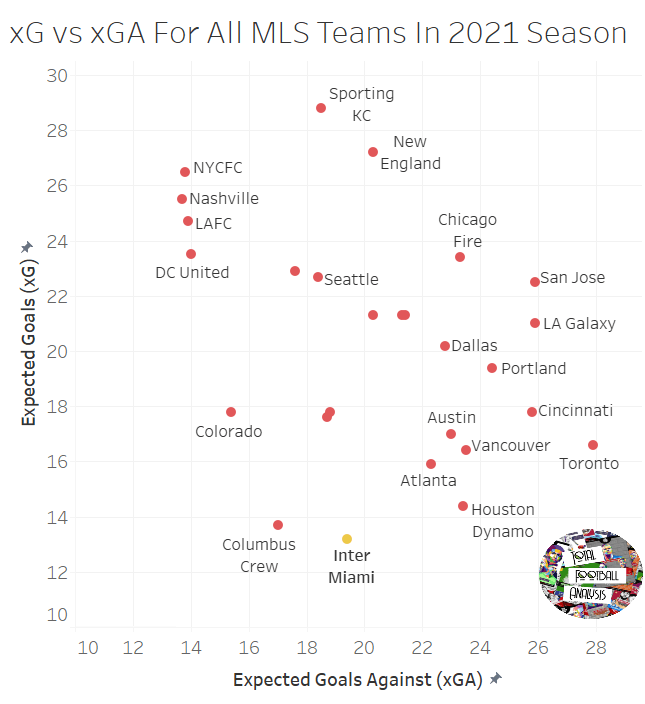
As can be seen from the graph above, Inter Miami are performing rather positively in terms of their expected goals against (xGA) with just 19.4 xGA, but they have the worst xG in the MLS.
In terms of expected goals, Miami have tallied 13.2 across the season so far in their 13 matches, meaning that they are underperforming by more than three goals and currently have the lowest xG in the MLS across both conferences.
For a squad that has one of the most prolific centre-forwards in Europe from the last decade, Gonzalo Higuain, it is an abhorrent record and something that needs to change fast.
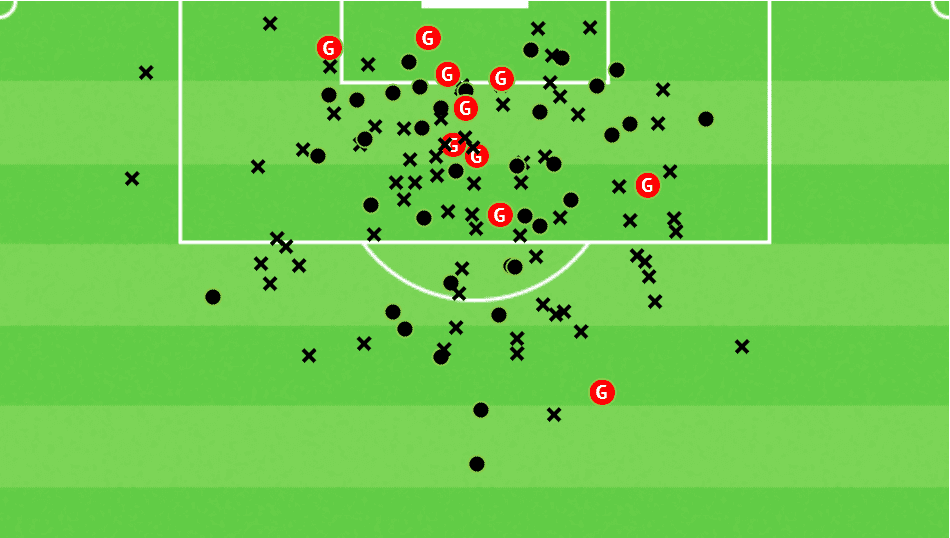
This data visualisation shows each of Inter Miami’s shot locations from this season so far. As can be seen, the vast majority of their shots are coming from inside the area, although not many are from inside the six-yard box. Miami are still shooting a high volume of shots from outside the box too, but this has resulted in just one goal so far.
One of the main reasons why Miami are struggling to score though is because, for all their efforts on goal, the majority of their shots have a relatively high xG per shot but a low goal per shot ratio.
Inter Miami’s team are averaging 0.122 xG per shot in the 2021 MLS campaign but are scoring just 0.07 goals per shot. To put this into perspective, Miami should be scoring around 12 percent of their shots but instead are averaging at around 7 percent.
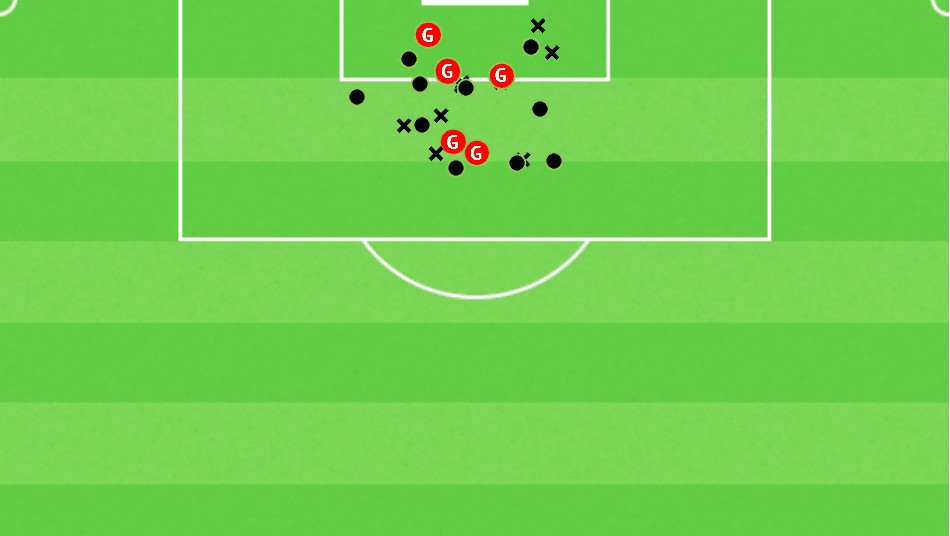
This data visual above portrays the number of shots Inter Miami have had which accumulated an xG of more than 0.2 per shot. As can be seen above, this is insurmountably low in comparison to their volume of shots overall.
Only the forwards to blame?
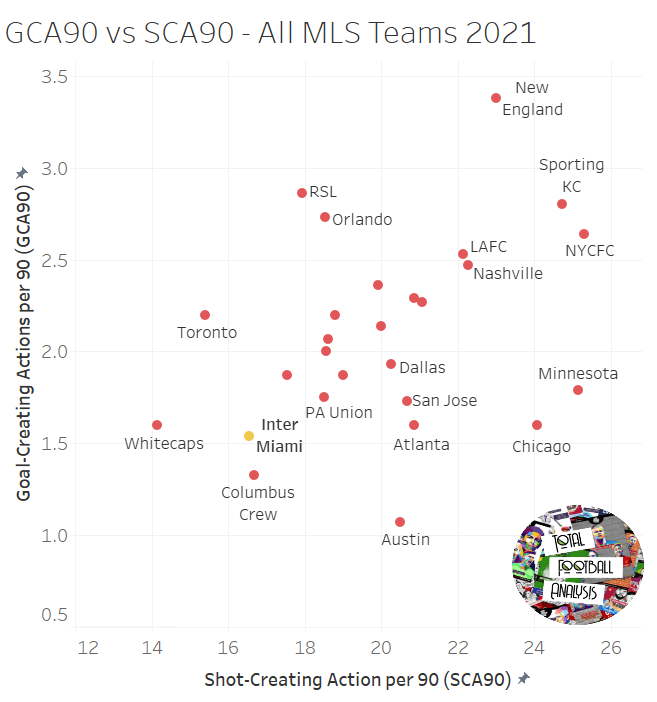
Looking at this graph, it is obvious that the centre-forwards’ lack of end product is not the only factor behind why Inter Miami are failing to score goals under Neville. The graph measures goal-creating actions per 90 (GCA90) and shot-creating actions per 90 (SCA90) to portray a team’s creativity.
StatsBomb notes GCA90 as the two offensive actions right before a goal, such as a dribble, a pass, or even a foul, while SCA90 are the two offensive actions right before a shot is taken by a team.
The graph conveys that Miami are performing abominably on both of these fronts. They rank as the third-lowest team in terms of both goal-creating actions per 90, with 1.54, and shot-creating actions per 90 with 16.54.
Need to change set-up in possession?
A reasonable hypothesis as to why these numbers are so low is because of the style of football has his side playing. Inter Miami are quite a pragmatic and direct team that like to sit deeper and hit the opposition on the break in order to create the bulk of their chances. Miami have averaged just 45.5 percent ball possession this season, the second-lowest in the MLS across both conferences with only Houston Dynamo performing worse on this metric.
Miami tend not to build up through the thirds, especially against tougher opposition and opt instead for a direct ball from the goalkeeper. Neville deploys a 4-2-3-1 and has done in 64 percent of his matches this season with the 4-4-2 being the second-most utilised formation by the Englishman.
When in this structure, the centre-forward, typically Higuain, tends to drop deep as he is aerially proficient and can be the main target man from the long kickouts.
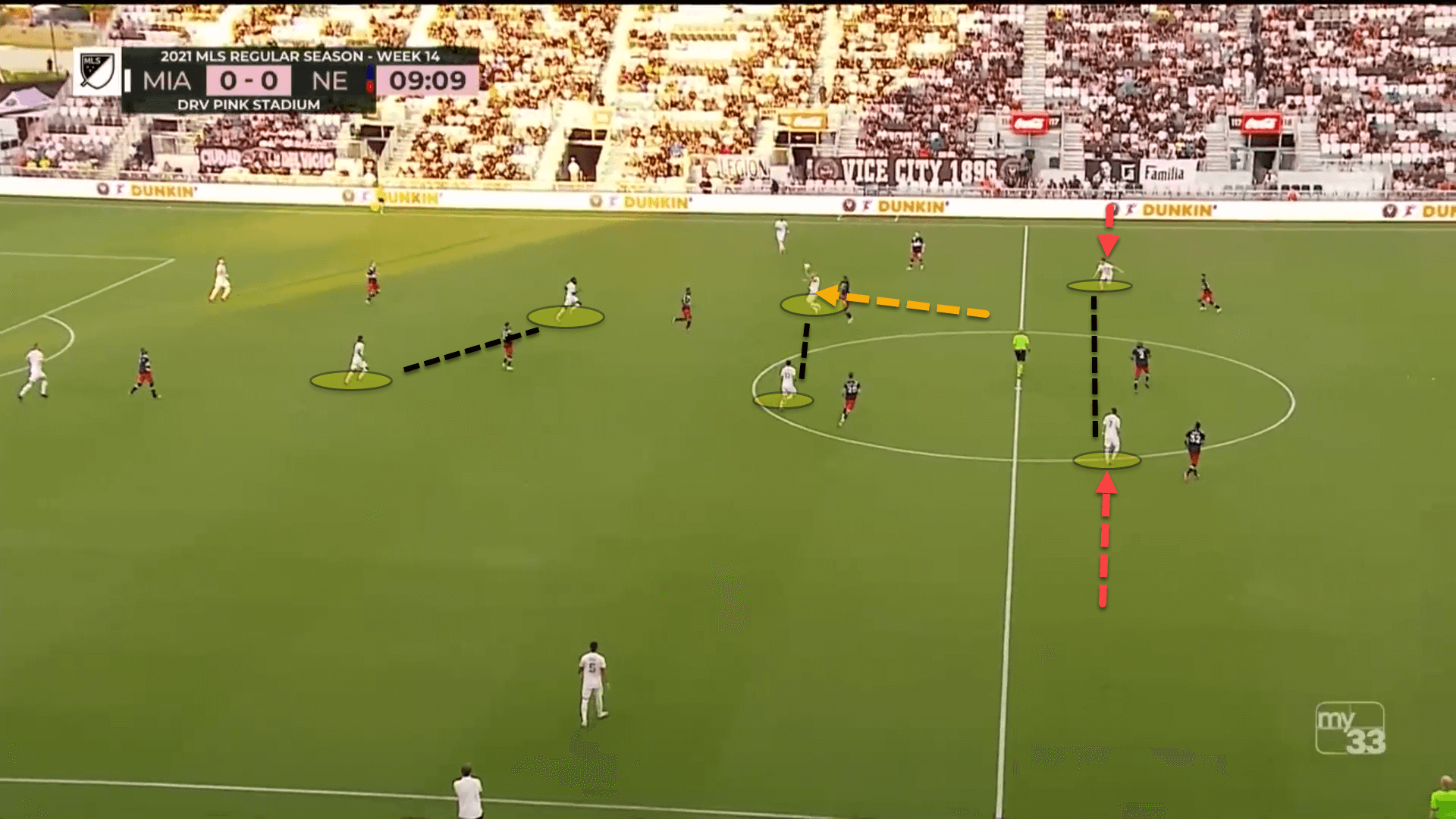
When this occurs, the two wingers push inside and attack the space vacated by the centre-forward which results in the formation changing to more of a 4-2-2-2 or 2-4-2-2 depending on the fullbacks’ positioning.
There is no problem with going direct as a form of progressive play, despite the stigma surrounding it. However, Inter Miami are not very good at it. The Herons average 36.11 direct passes per 90 but have a total accuracy of just 57.1 percent, which is one of the lowest in the MLS.
Perhaps it is time that Neville decides to change up his team’s approach in games. In recent matches, evidence can be seen that Miami are trying to have more of the ball. Whilst they have averaged 45.5 percent possession in the current campaign, in the previous two matches, they managed to have 51.09 percent and 52 percent ball possession.
The issue is, as shown with their use of goalkicks, they are poor at progressing the ball, particularly in progressing the ball into the final third.
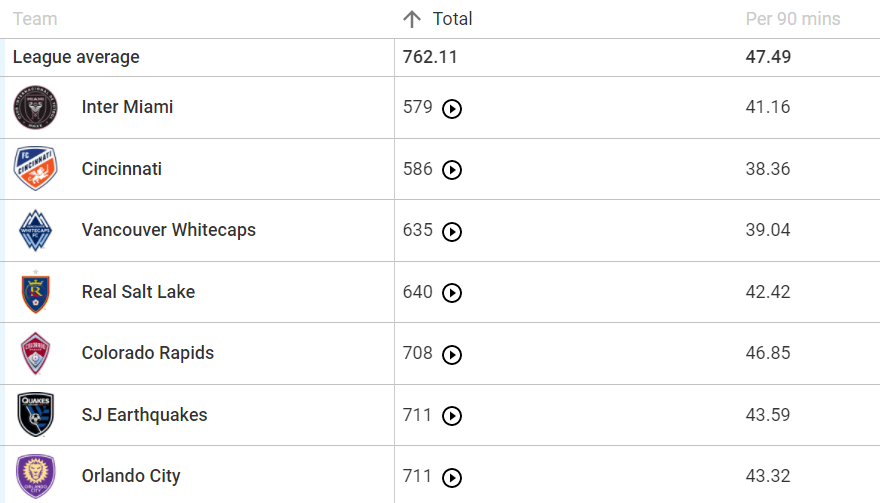
The table above shows the seven teams with the lowest number of final third entries in the MLS this season. Inter Miami have the lowest number across both the Eastern and Western Conferences with just 579 entries and the third-lowest in terms of passes to the final third per 90 with 41.16.
In total, Miami have the lowest number of touches in the box too with 219 which is merely 16.8 touches per 90, a very low number.
One of the reasons for this is the team’s poor occupation of space. Miami tend to pack the box and hit balls into the penalty area from deeper positions without any real thought process behind it. Unless the cross into the area is pinpoint, this is far too easy to defend against.
Their positional attacks need to be structured better too as this will help them in defensive transition.
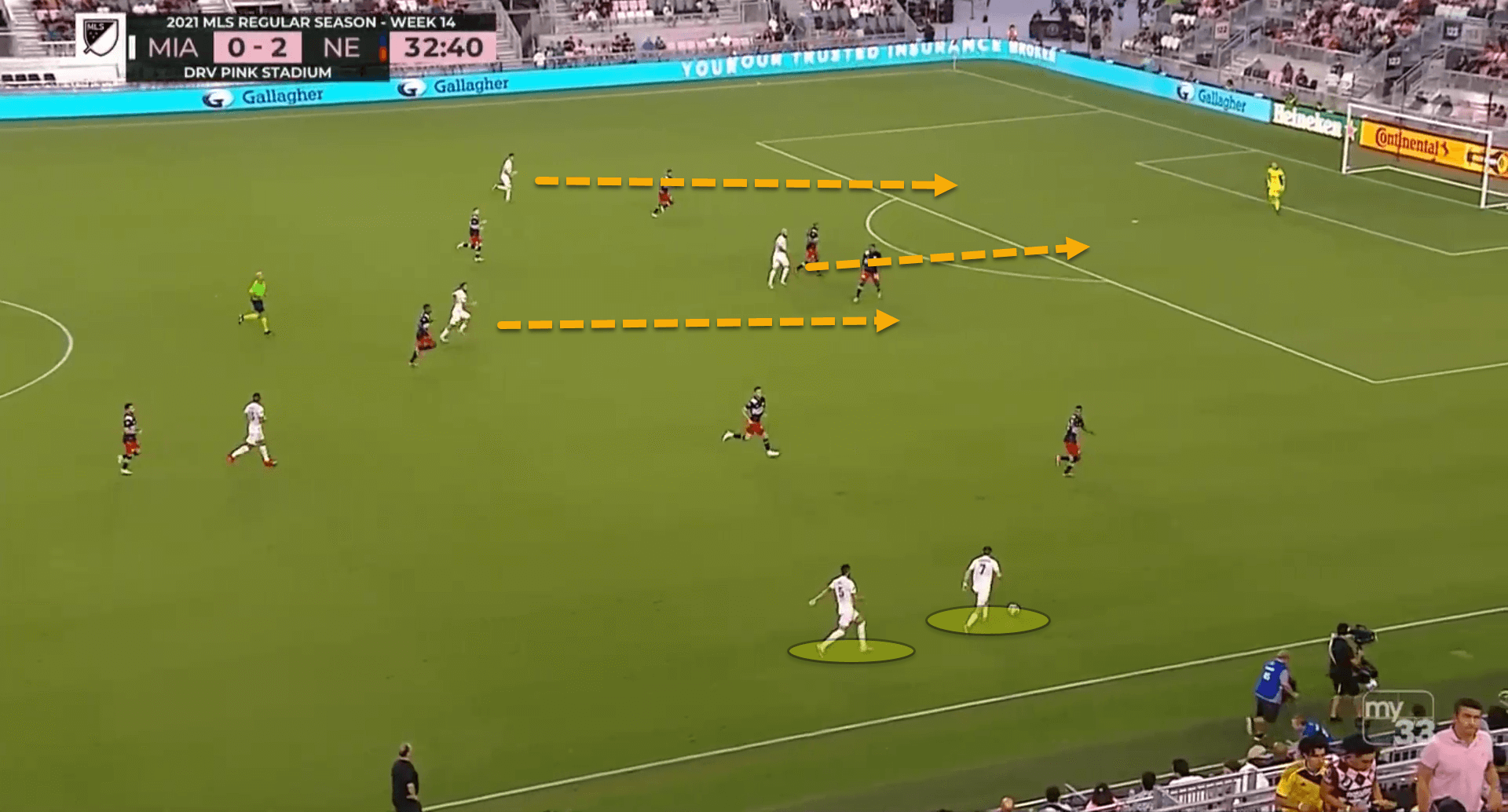
Here is an example of a positional attack from Inter Miami in a recent game against the New England Revolution. The players are all very far apart, making it extremely difficult to counterpress when the ball is lost as the connections between the players are stretched.
The right-back and right-winger are also occupying the same vertical line, which is pointless. One player should be making a run into the halfspace to take one of the two nearest defending players away and creating a 1v1 situation on the flanks.
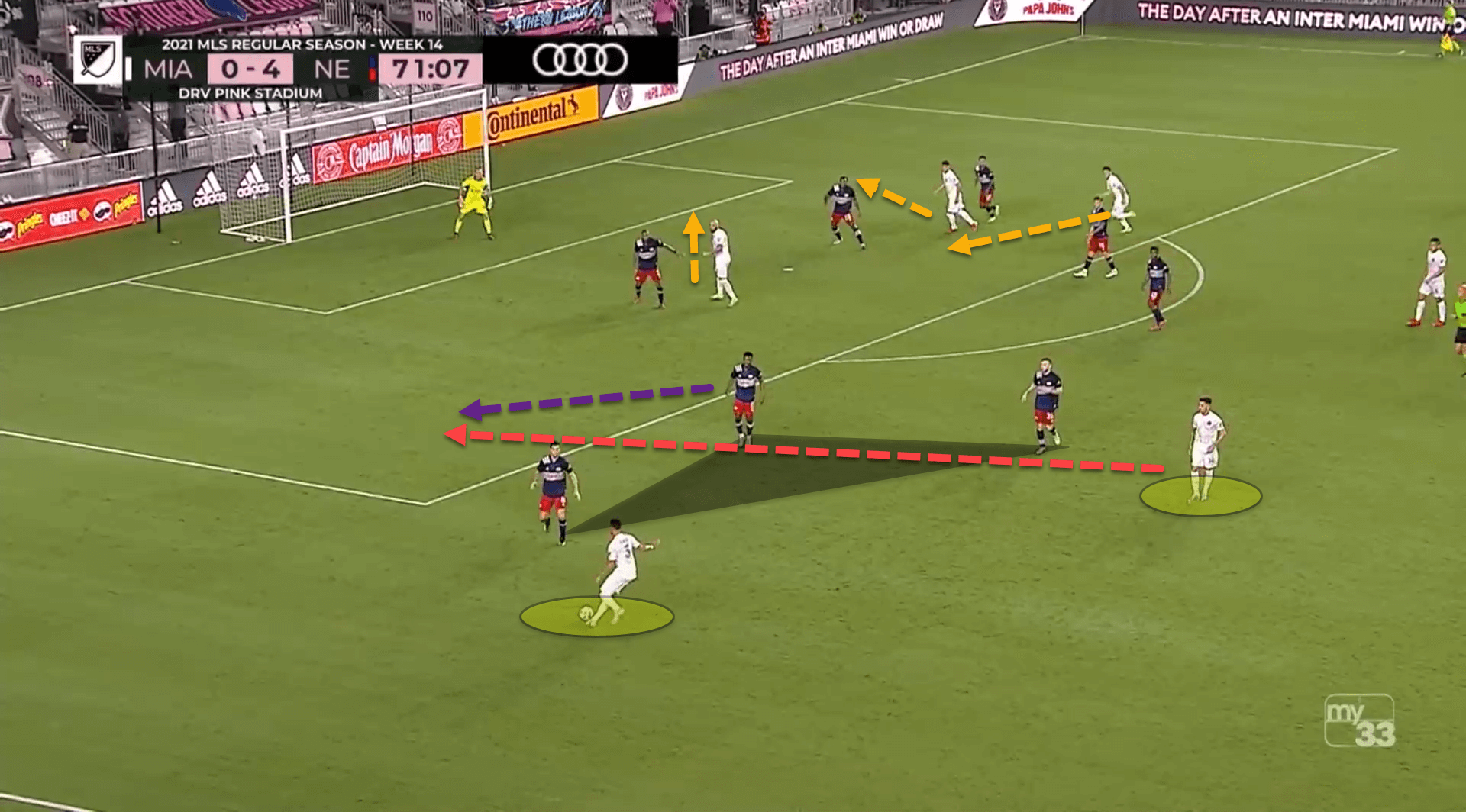
Here is another example of a poor positional attack in the final third by Inter Miami. The left-back is looking to hit the ball into the box using an early cross, but this is easily defended by the Revolution.
The ball-near midfielder opts to stay static rather than making a halfspace run to drag away one of the defending players. Making a run in the halfspace would have dragged the defender away and possibly allowed the fullback to go 1v1 with his opposite number.
Also, as can be seen in the above image, the two players are outnumbered by three of the opponent’s defenders. Should they lose possession here, counterpressing is so much harder as they would have one player less. Another midfielder should have come across to offer a passing lane and to help ensure that they were not outnumbered should they lose possession – a basic principle of modern positional play.
Miami need to be more structured in their play. Piling players into the box is a good way of scoring goals but is pointless if the ball cannot be facilitated into the area.
Pressing angles and stagnating midfield lines
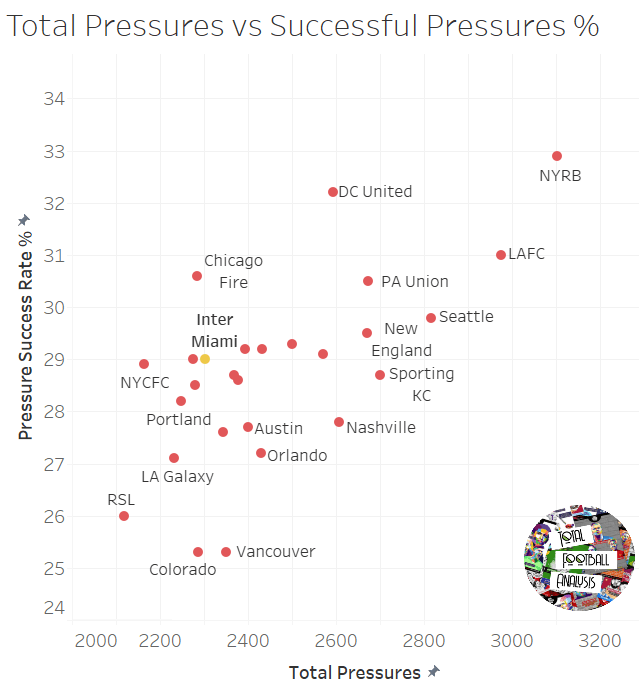
Looking at the graph above, Miami are quite a low pressing side but have a decent pressing success rate of 29 percent. Neville instructs his side to mainly sit in a mid-to-low level defensive block during games and Miami do not press too much in the initial defensive phase. In fact, the Herons have the fourth-lowest pressures in the attacking third according to FBref.
A hypothesis as to why Miami do not press high is because Higuain is extremely lazy when it comes to pressing opposition centre-backs. This can make it extremely difficult for Neville to set up his side defensively. Andrea Pirlo had the same issue with Cristiano Ronaldo last season at Juventus.
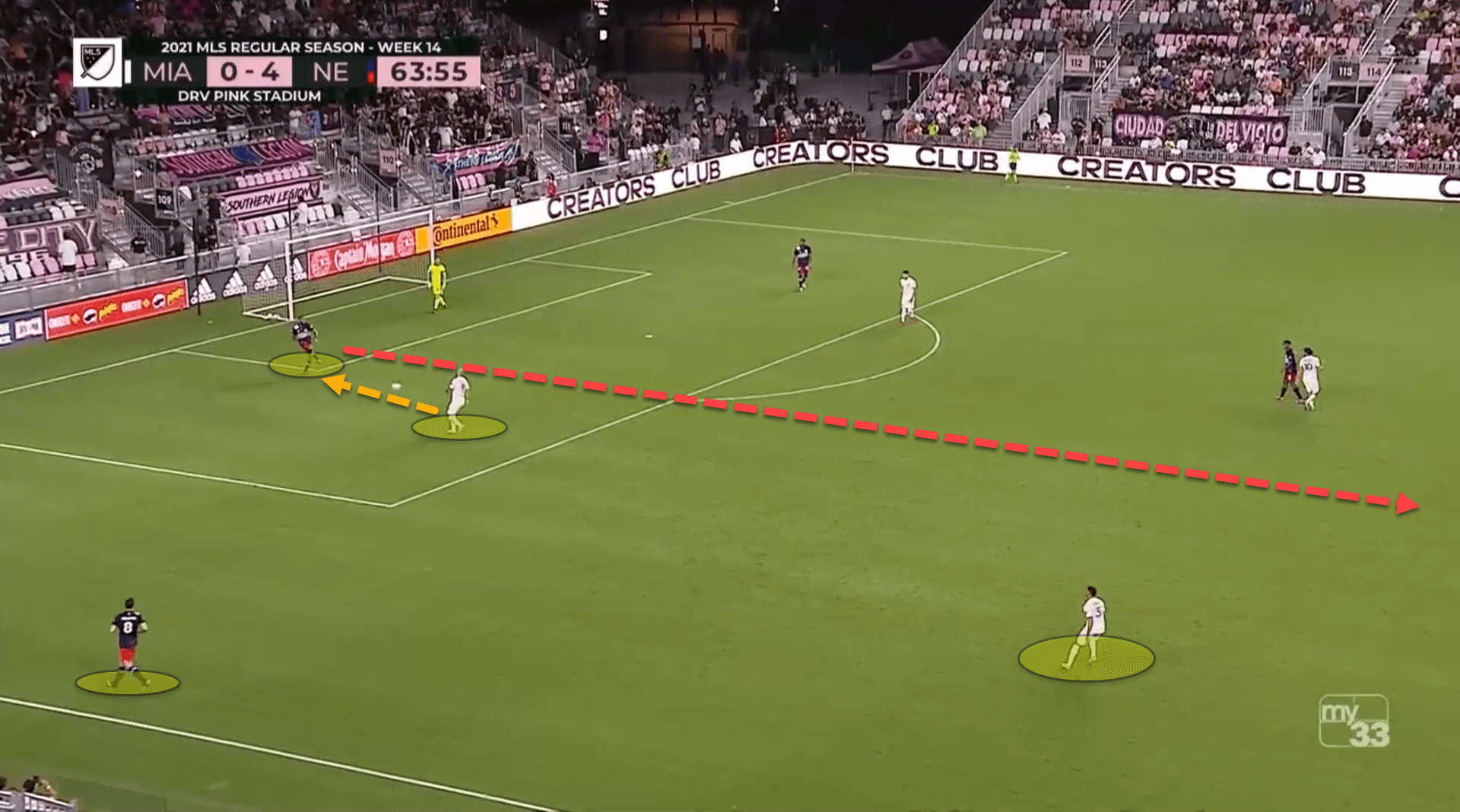
Here, Higuain is putting pressure on the centre-back. However, he has not angled his run to cut off any passing lane behind him or beside him and the central defender easily bypasses this and plays the ball straight into the midfielder who dropped, really poor pressing from a player who has played at some of the biggest clubs in world football.
Having players in the first line of pressure who press so poorly, and cannot even angle run, makes pressing next to impossible, hence why Miami sit in deeper blocks. Since the 4-2-3-1 is their usual base formation, it switches to a 4-4-2 out of possession.
Miami’s issue with defending in a deeper mid-to-low block is that they tend not to stagger their midfield lines, which makes it extremely easy to play through them at times.
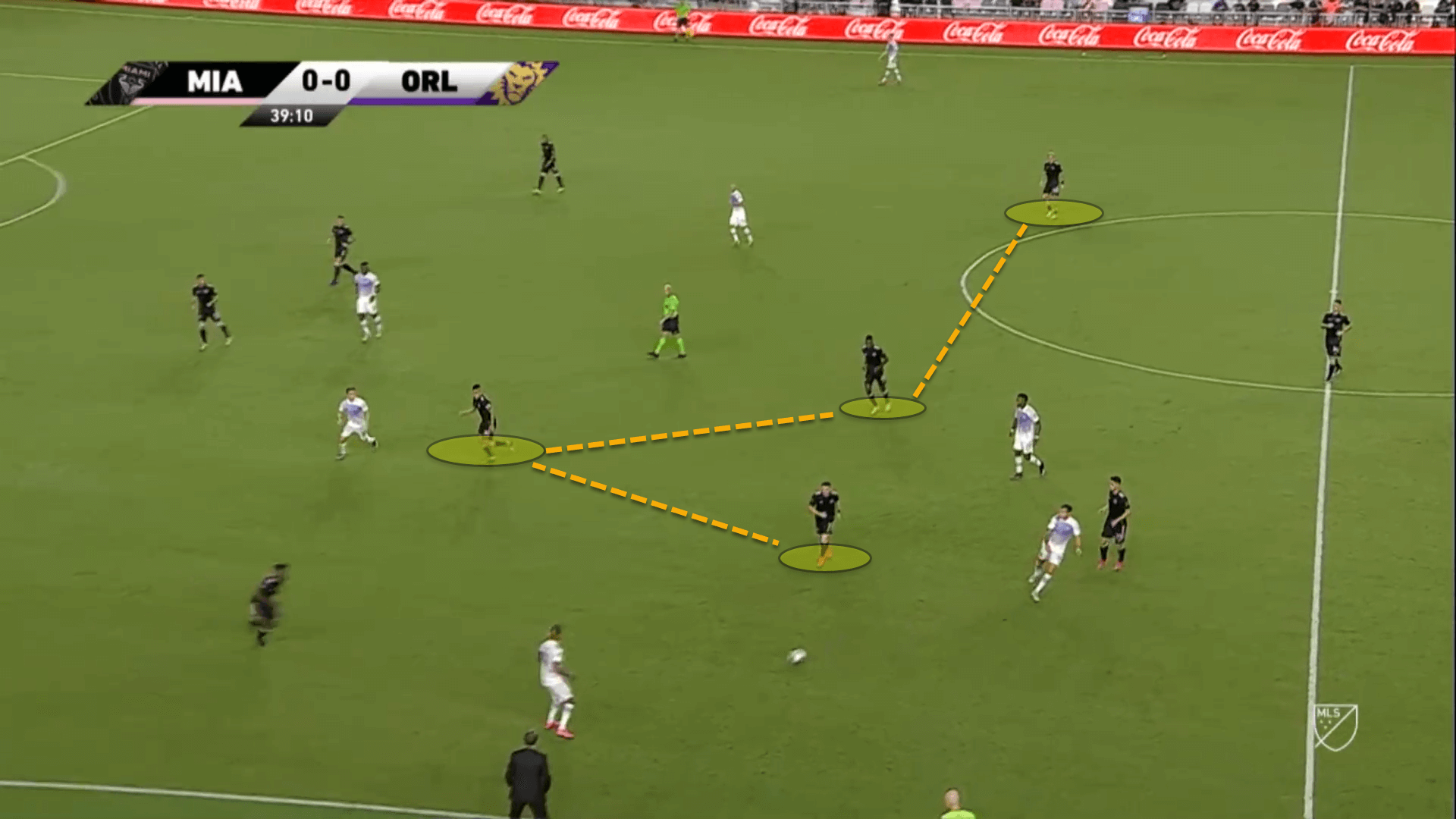
This image is an example of where Miami staggered the midfield well and prevented any ball progression, forcing Nani to play backwards with his back turned to goal. The ball-near midfielder has dropped deep to pick up the Orlando City centre-forward in the halfspace, which has caused the midfield to stagger.
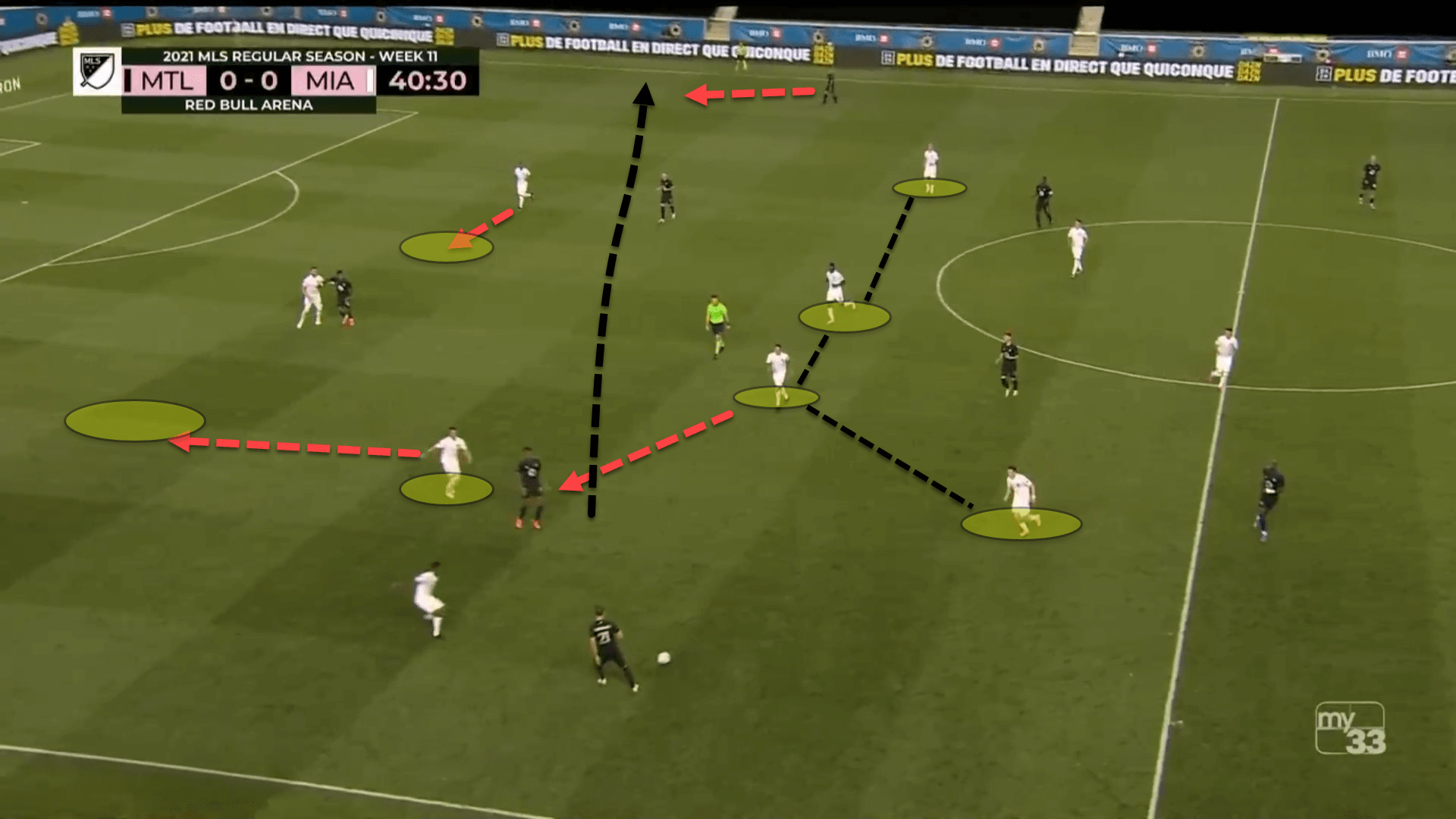
Now, here is an almost identical scenario against Montreal Impact, which Miami did not defend well against at all. The ball-near midfielder did not drop and pick up the player in the halfspace, staggering the midfield. Instead, the ball-near centre-back was forced to come out and aggressively close him down.
In turn, the Inter Miami left-back and centre-back came across to cover the space left by the ball-near centre-back. This left a huge amount of space for the opposition’s wingback to receive into and Montreal subsequently scored from this switch of play.
Unfortunately, the latter scenario happens far too often and is a clear structural problem that needs to be dealt with by Neville and his coaching staff.
Defensive transitions from set-pieces
Another vital area that needs work is Inter Miami’s failure to deal with defensive transitions from set-pieces. This is a coaching issue as opposed to one caused by the players.
Miami have been carved open too many times this season from their poor set-up during set-pieces. The Herons tend to put nine players into the final third. Two players stand over the ball, one or two stay at the edge of the area to clean up any balls that drop during the second phase, while five or six pack the box. This means that there is just one outfielder back defending at the halfway line.
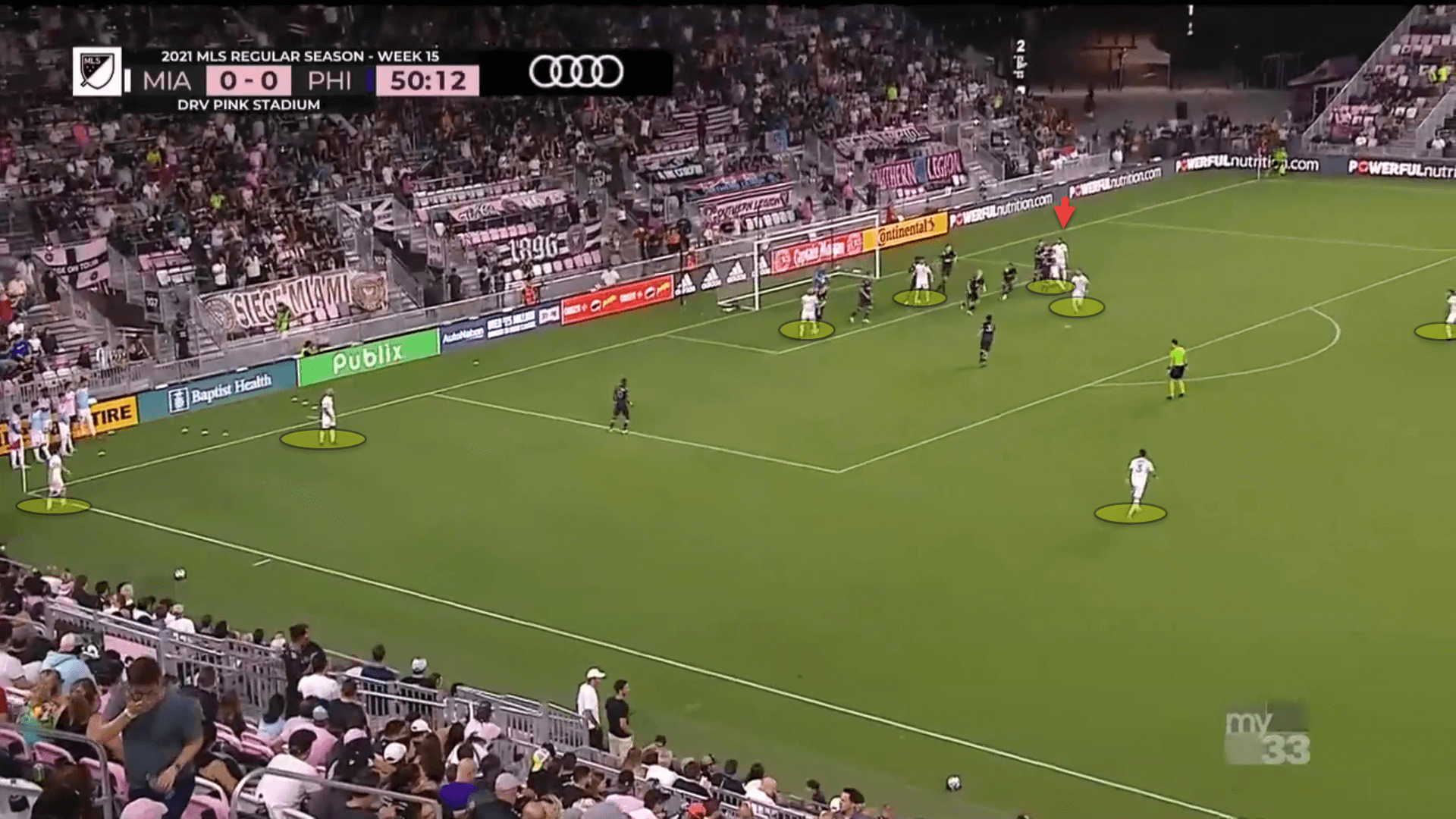
Of course, the issue with this is that there is just one player back defending the halfway line. If the opposition regains possession and bypasses the players surrounding the edge of the box, Miami are in extreme danger.
Bruce Arena’s New England were so efficient at exploiting this in their recent 5-0 victory at the Miami Freedom Park.
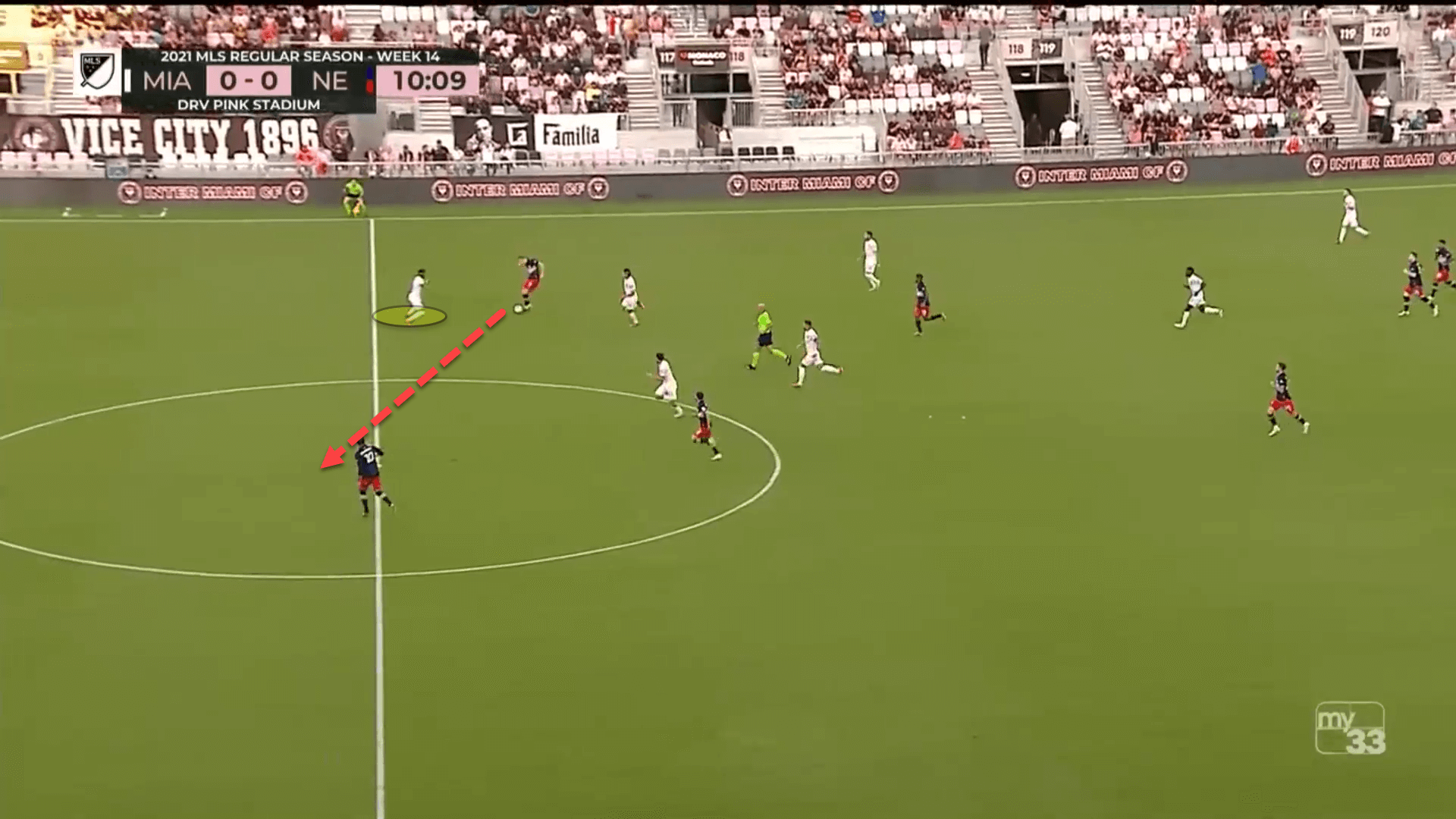
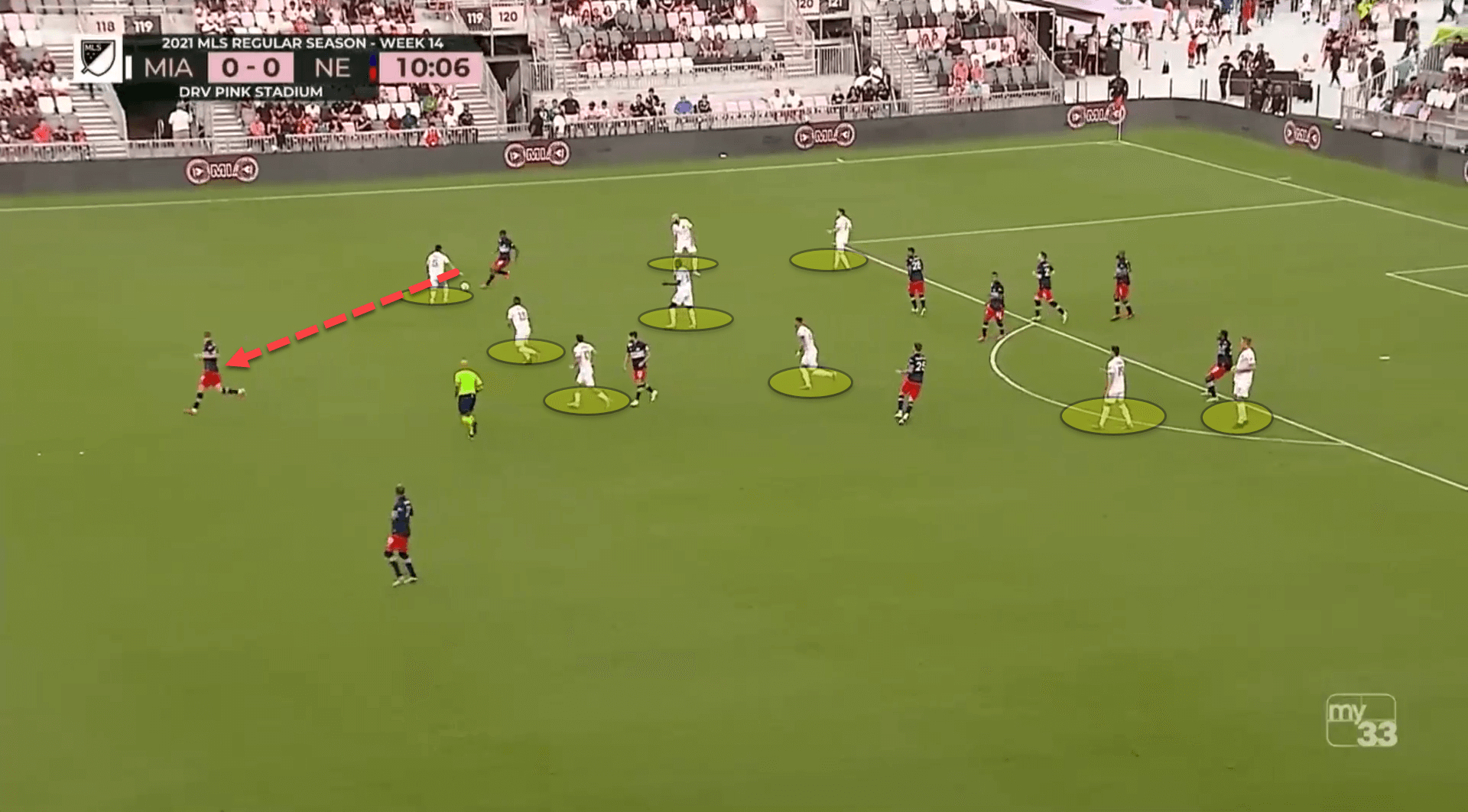
New England scored from this situation. Luckily for Miami, it was ruled as marginally offside, but the Revs scored numerous goals from defensive transitions shortly after as Miami had not learned their lesson.
Neville needs to learn to set his side up better at set-pieces in order to ensure that they are more protected defensively should the opposition regain possession. The head coach can either keep an extra man at the halfway line or else put three at the edge of the box to sweep up in the second phase.
Conclusion
It is not looking good for Neville at the moment. Inter Miami have picked up just one point from a possible 21 available in the last seven league matches. Structurally, there is quite a lot for the former Everton and Manchester United player to fix and it needs to be fixed fast, or else he may find himself looking for another job very soon.






Comments